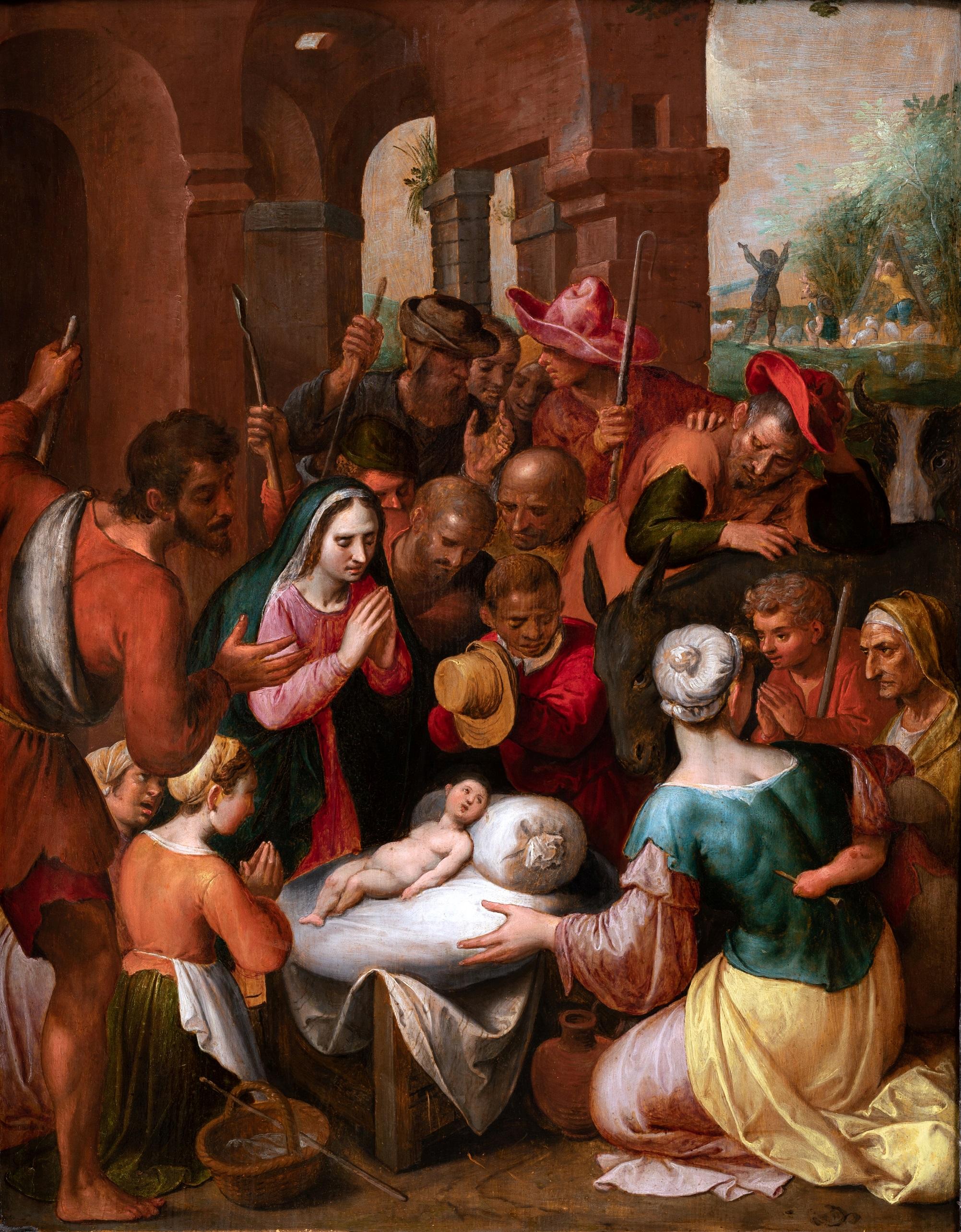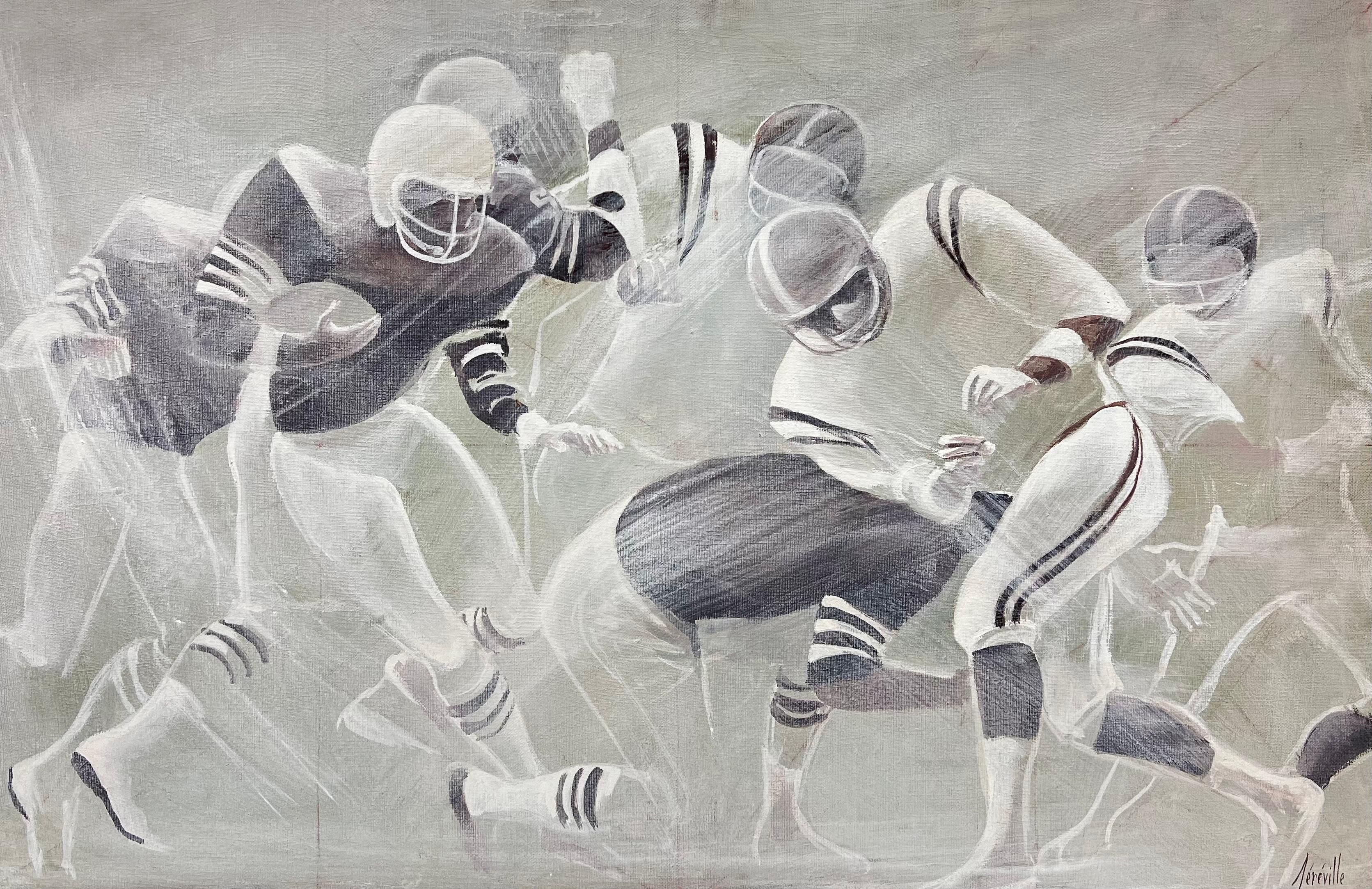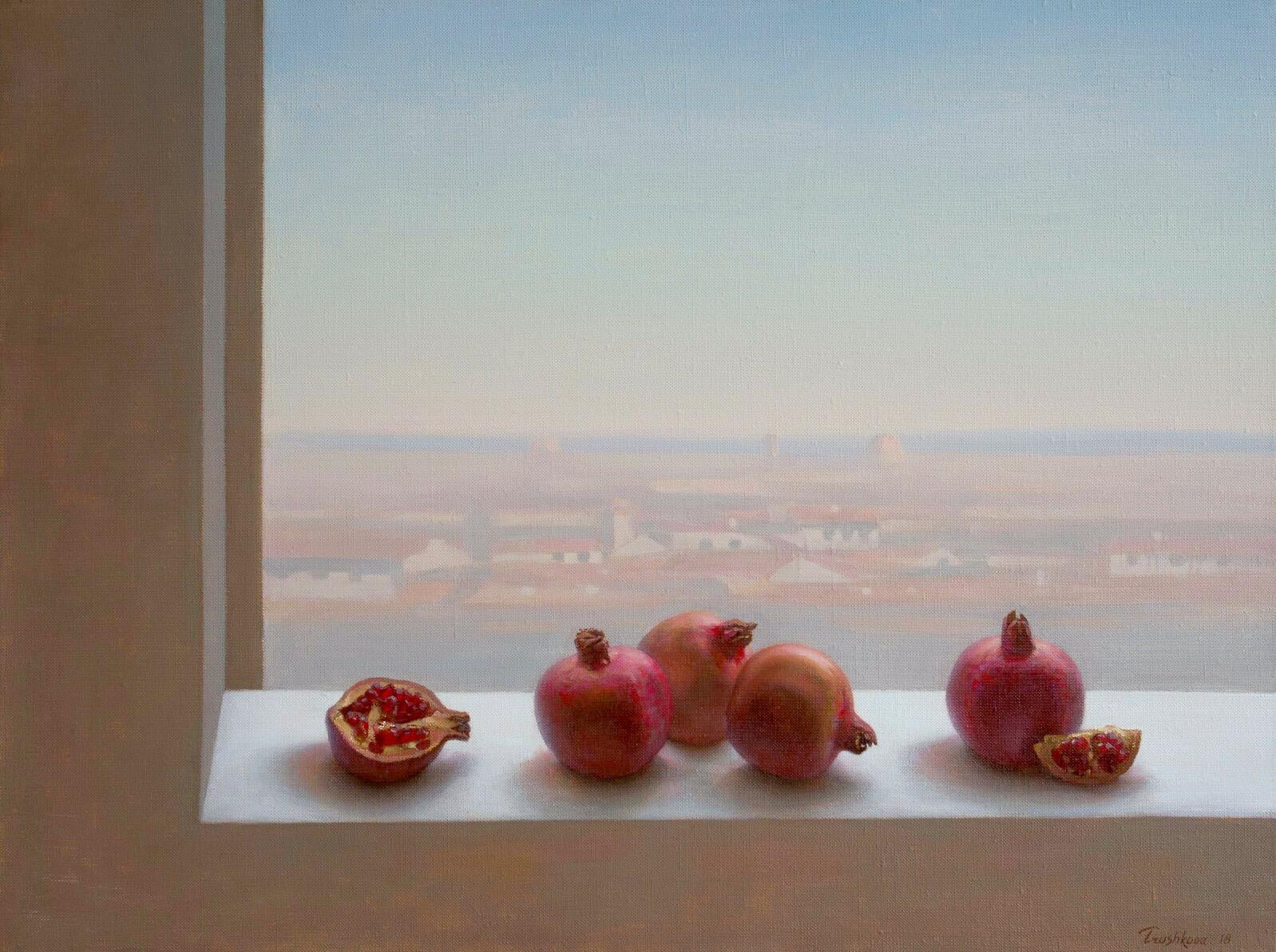Items Similar to Madonna Enthroned with Child between angels and saints Nicholas of Tolentino
Want more images or videos?
Request additional images or videos from the seller
1 of 18
UnknownMadonna Enthroned with Child between angels and saints Nicholas of Tolentino1500s
1500s
About the Item
The painting features the enthroned Madonna and Child, two praying angels, and Saints Nicholas of Tolentino, Augustine, Luke the Evangelist, and Monica, below an elegant canopy. The work should be recognized as a preparatory sketch for a large altarpiece, still unknown today. Evidence of this is provided by the panel's measurements, which are not suitable for a church altarpiece or even for a small chapel in a private residence; by the painting, which in some places, such as the two angels on either side of the Madonna and Child or in St. Luke the Evangelist, is deliberately left in a sketchy state; and, finally, by the presence of obvious repentance. One can note in this regard the left arm of the holy bishop, initially thought to be closer to the right arm, and the right hand of the saint. Although the panel is a sketch, one can see details of great pictorial refinement, demonstrating the quality of the painter and the importance that these objects had with respect to the final work: the gold trimmings, for example in the Saint Nicholas of Tolentino, in the loincloth of the little angel in the upper left and in the globe held by the Child, enrich the preciousness of the composition. The somatic features of the figures are outlined at the tip of the brush, while the garments are constructed through more vigorous and less rigorous brushwork, further demonstrating that the work was not to be considered independent. Observe in this regard the cope of the holy bishop, in which we can glimpse figurative decorations-saints or apostles-and an imitation velvet decoration executed with a quick brushstroke that effectively traces only its general outline.
The saints are qualified by a bright palette that particularly highlights the central depiction with the Madonna and Child, St. Augustine, and the angel in the upper right corner. The shadows and lights are studied with special care: the two praying angels are enveloped in the shadows created by the canopy, and accurate are the chiaroscuro effects on St. Luke, St. Monica, and the steps of the throne. The presence of the canopy is a clear legacy of early sixteenth-century Florentine culture: one thinks of the altarpieces by Raphael (Madonna del Baldacchino, Palatina Gallery in Palazzo Pitti, Florence) and Fra Bartolomeo (Pala Pitti, Palatina Gallery in Palazzo Pitti, Florence), from which our painter takes-as was the norm still in the second half of the sixteenth century in Florence-the general composition of the Sacred Conversation.
Marco Collareta is credited with attributing the work to Santi di Tito (Borgo San Sepolcro 1536 - Florence 1603) on the occasion of the celebrated 1980 exhibition: Palazzo Vecchio: Medici patronage and collecting. On that occasion the scholar dated the panel in the mid-1560s, recognizing a close link with the altarpiece fired by the Tuscan painter in 1566 for All Saints in Florence and noting in the painting still "the memory of the chromatic vividness of the frescoes made by the painter during his stay in Rome by 1564" (M. Collareta, 552. Madonna and Child, Angels and Saints, in Palazzo Vecchio: Medici commissioning and collecting, Milan 1980, pp. 283-284)
The presence of the holy bishop Augustine and Augustinian saints Nicholas of Tolentino and Monica leaves no doubt in estimating that the work was commissioned by a community of Augustinians or by a private individual devoted to that order. The Evangelist's presence could be motivated by the dedication of an altar or chapel to that saint, or by the patron whose name must have been Luke. The basilica of Santo Spirito is the home of the Augustinians in Florence and could certainly be a place for which Santi di Tito worked here. Considering how the painter, an absolute protagonist of Florentine and Tuscan painting in the second half of the 16th century, was engaged in different commissions in the Florentine countryside and Tuscany (e.g., in Arezzo, Cortona, and Grosseto) and the widespread diffusion of the Augustinian order in this and other regions, it remains difficult to specify its location.
- Creation Year:1500s
- Dimensions:Height: 34.06 in (86.5 cm)Width: 28.15 in (71.5 cm)Depth: 1.97 in (5 cm)
- Medium:
- Period:
- Condition:
- Gallery Location:Milan, IT
- Reference Number:1stDibs: LU680314080222
About the Seller
4.8
Gold Seller
These expertly vetted sellers are highly rated and consistently exceed customer expectations.
Established in 2017
1stDibs seller since 2017
102 sales on 1stDibs
Typical response time: 1 hour
- ShippingRetrieving quote...Ships From: Milan, Italy
- Return PolicyA return for this item may be initiated within 14 days of delivery.
More From This SellerView All
- David and Abigail, fourth decade of the 17th centuryLocated in Milan, ITThe painting, done in oil on canvas, depicts the meeting between King David and Abigail, as narrated in the biblical text from the First Book of Samuel (I Samuel 25:1-34). David, left without food in the wilderness with his army, seeks relief from the wealthy Nabal, who contemptuously denies him any help, ungrateful of the benevolence he previously received from the king. Upon hearing the rejection, the ruler intends to take revenge by killing his entire lineage. Abigail, Nabal's beautiful and wise wife, decides to right the wrong and bring David plenty of food and gifts. In the king's presence the woman humbles herself, winning his forgiveness and benevolence. Soon afterwards widowed, she will in fact become his bride. The broad scene depicts the climax of the Old Testament episode, the moment when the woman prostrates herself before David and his servants prepare to deliver the gifts. The biblical event is here a pretext, as is customary in modern-age painting, for staging the colorful description of a sumptuous procession, which can be divided into two parts, almost two wings of a crowd divided specularly: on the left David with his dignitaries and the army; on the other, Abigail's retinue, handmaids, servants leading dromedaries and donkeys laden with food. The crowded group of figures is set in a natural proscenium: above a low horizon, barely hinted at by distant blue mountains, rises on the left side a craggy rocky cliff, the shelter of the army led by the ruler. The 'somatic intonation of the characters, as well as the choice of metallic chromatics and the play of light on the shiny fabrics refer to a clear Flemish matrix, particularly the influence of the frothy and sumptuous painting of Rubens and Van Dyck. As well set forth in the expert report prepared by Professor Giuseppe Sava, the work is to be attributed to Vincent Malò...Category
17th Century Other Art Style Figurative Paintings
MaterialsOil
- Madonna and Child with St. John, c. 1540-1560. Attributed to Carlo PortelliLocated in Milan, ITThe painting features Our Lady holding the Child, who extends his hand toward the wooden cross, the symbol of the future Passion, and St. John. Behind the three figures a rocky mount...Category
18th Century and Earlier Other Art Style Figurative Paintings
MaterialsOil
- The Preaching of St. John the Baptist, Workshop of Fans Francken II, 1600sLocated in Milan, ITThe sermon of the Baptist is set in a large open space, with rich vegetation and wooded glimpses, and on the back, in the distance, you can see the buildings of a city. The scene see...Category
17th Century Other Art Style Figurative Paintings
MaterialsOil
- Mythological Subject, Italy XVII Century, The Tale of Apollo and MarsyasLocated in Milan, ITOil painting on canvas. Northern Italian school of the seventeenth century. The large canvas derives from an engraving of 1562 by the Venetian Giulio Sanuto, who faithfully reproduce...Category
17th Century Other Art Style Figurative Paintings
MaterialsOil
- Penitent Magdalene and St. John the Baptist, oil on slate, early 17th centuryLocated in Milan, ITThe figure of the Magdalene emerges from the darkness, leaning to follow the curve of the stone support; it is depicted vaulted with an interrogative air towards the dark, as if in an attitude of listening, the left hand raised and the other leaning on the "memento mori" very shortened. In front of her a scourge and the jar of ointment. Painted en pendant, Saint John the Baptist is depicted as a young man, with a lamb at his feet, in his hand the processional cross with the banner "exception agnus dei", while with his right hand he draws from the source of water, recalling the episode that will see Jesus Christ baptized. In both paintings the figures stand out in a strong and incisive way thanks to the black that characterizes the slate plate on which they are depicted. Historical-critical analysis: We are faced with two examples of oil painting on stone. The beginnings of this particular technique are to be placed in the first half of the sixteenth century: after some fifteenth-century experiments it is with Sebastiano del Piombo that the genre takes hold in the sixteenth century. There were different types of support used, also linked to their availability: amethyst, marble in various colors, alabaster and blackboard. The reasons underlying this technical choice refer to Renaissance artistic theories: it is no coincidence that the painter who most often experimented with oil painting on marble...Category
Early 17th Century Other Art Style Figurative Paintings
MaterialsOil
- Painting The Deposition of Christ 18th centuryLocated in Milan, ITOil on Canvas. Neapolitan school of the seventeenth-eighteenth century. It is a traditional scene of Christ's deposition from the Cross, with his inert, pale body lowered into the ar...Category
18th Century Other Art Style Figurative Paintings
MaterialsOil
You May Also Like
- French Surrealist Oil Painting Cubist Figurative Scene 20th centuryLocated in Cirencester, GloucestershireFigurative Abstract French School, signed oil painting on board framed: 21.25 x 30.75 inches canvas: 20.5 x 30 inches The painting is in overall good condition, bar an age related pa...Category
20th Century Surrealist Figurative Paintings
MaterialsOil
- Cercle of Ambrosius Francken, Adoration of the shepherds, 17th century AntwerpLocated in PARIS, FRAdoration of the shepherds, Cercle of Ambrosius Francken, Early 17th century Antwerp school Oil on oak panel: h. 55 cm, w. 43 cm (21.65 in x 16.93 in) 17th c. ebonized and moulded f...Category
Early 17th Century Old Masters Figurative Paintings
MaterialsOil, Wood Panel
- Fate Challenge I (lady climber wildcat brown earth tones yellow ochre mauveBy Rudolf KosowLocated in Quebec, QuebecIn "Fate challenge II“ a mountaineer is eagerly climbing a steep rock ledge because she has seen something from a distance that she could not explain and is planning to find out. Alt...Category
2010s Surrealist Figurative Paintings
MaterialsCanvas, Oil
- 17th century Italian figure painting - Fall of Fetonte - Oil on copper LandscapeLocated in Varmo, ITRoman master (c. 1650) - The Fall of Phaeton. 40.5 x 52.5 cm without frame, 56.5 x 59.5 cm with frame. Oil on copper, in carved and gilded wooden fra...Category
Mid-17th Century Baroque Figurative Paintings
MaterialsCopper
- American Soccer Game, Dramatic 20th century Oil Painting, signed 1980's periodLocated in Cirencester, GloucestershireArtist/ School: French School, circa 1988, signed and inscribed verso Title: American Soccer players Medium: oil on canvas, framed Framed: 24 x 37 inches Canvas : 23.75 x 36.5 i...Category
Late 20th Century Modern Figurative Paintings
MaterialsOil
- Florence -original still life painting-original realism still life oil paintingLocated in London, Chelsea"Florence," a captivating Impressionistic masterpiece by the talented artist Irina Trushkova, beautifully captures the essence of one of the world's most enchanting cities. Rendered ...Category
21st Century and Contemporary Photorealist Still-life Paintings
MaterialsCanvas, Oil




